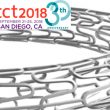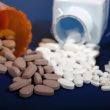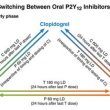Optical coherence tomography (OCT)-guided drug-eluting stent implantation improves early strut coverage compared with angiography-guided angioplasty. No difference was observed in terms of strut coverage between permanent-polymer everolimus-eluting stents and bioresorbable-polymer biolimus-eluting stents. Short-term dual antiplatelet therapy may be feasible in selected patients with early strut coverage. This study sought to measure early strut coverage...
Safety of Combining New Anticoagulant Agents and Dual Antiplatelet Therapy
Atrial fibrillation is the most common arrhythmia and its combination with a history of acute myocardial infarction or coronary angioplasty is quite frequent. According to this study (recently published in JACC), in a real-world population, the combination of direct anticoagulant agents and dual antiplatelet therapy reduces significantly the risk of bleeding and provides similar thromboembolic...
TCT 2018 | LEADERS FREE II: Polymer-Free DES in Patients at High Risk for Bleeding with 1 Month of Antiplatelet Therapy
This study was aimed at gaining device registration from the US Food and Drug Administration (FDA) for a polymer-free biolimus A9 drug-coated stent (BioFreedom, Biosensors). The study had two purposes: on the one hand, it meant to reproduce the results of the LEADERS FREE trial (published in 2015) in terms of safety and efficacy with...
What Antiplatelet Therapy Should We Use in Patients with Stroke/TIA? Interesting Results for the POINT Trial
Courtesy of Dr. Alejandro Lakowsky, MTSAC (Full Member of the Argentine Society of Cardiology) The New England Journal of Medicine (NEJM) recently published an article about the POINT trial (simultaneously presented at the European Stroke Organisation Conference), a long-awaited randomized clinical trial to assess the efficacy and safety of dual antiplatelet therapy (DAPT) with aspirin...
Dual Antiplatelet Therapy: Less Is More for Elderly Patients
A recent meta-analysis that will be published soon in JACC Intv offers evidence of benefit derived from short-term dual antiplatelet therapy for elderly patients. This is a patient group that has always been excluded from the major trials, while remaining one of the most challenging subgroups in which to balance bleeding and ischemic risks. The...
What Is the Best Antiplatelet Therapy in Primary Angioplasty at 12 Months?
Both prasugrel and ticagrelor showed superiority in terms of efficacy, reducing the number of major cardiovascular events at the expense of increased bleeding. This is an affordable cost, and the net clinical benefit supports these new antiplatelet therapies. The one-year follow-up of the PRAGUE-18 study focused on a comparison of efficacy and safety between prasugrel...
Clinical and Economic Costs Compete in the De-Escalation of Antiplatelet Therapy
Patients undergoing primary angioplasty for ST-segment elevation acute myocardial infarction have similar clinical outcomes at 1 year regardless of whether they are treated with ticagrelor or prasugrel, according the PRAGUE-18 study. This new substudy adds an interesting detail: patients who switched from prasugrel and ticagrelor to clopidogrel, citing economic reasons for the “de-escalation” of therapy, were...
When and How to Switch Dual Antiplatelet Therapies
Dual antiplatelet therapy with aspirin and a P2Y12 inhibitor is the treatment of choice for patients with acute coronary syndrome who undergo coronary angioplasty. Different oral P2Y12 inhibitors (clopidogrel, prasugrel, ticagrelor) present different characteristics as regards efficacy, risk for bleeding, cost, and timing of administration. In this sense, physicians frequently switch among drugs according to...
Angioplasty Complexity May Define the Duration of Dual Antiplatelet Therapy
The DAPT study concluded that continued thienopyridine plus aspirin beyond a year after coronary angioplasty is associated with a decrease in the rate of stent thrombosis and major cardiovascular events. In contrast, there is a significant increase in moderate to severe bleeding when compared with continued aspirin alone. Based on the outcomes of this and...
TCT 2017 | SENIOR: DES with a Bioresorbable Polymer and Short Dual Antiplatelet Therapy in Elderly Patients
Courtesy of the SBHCI. This study sought to assess the safety and efficacy of an everolimus-eluting stent with a biodegradable polymer (SYNERGY II) vs. a conventional stent (REBEL) in patients >75 years old with short duration of dual antiplatelet therapy. Before randomization, investigators recorded the planned duration of dual antiplatelet therapy (1 month for stable patients and 6 months...









